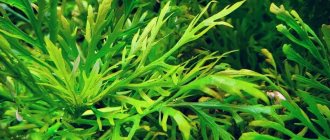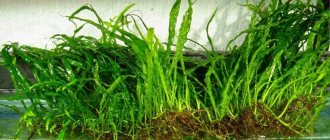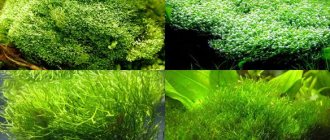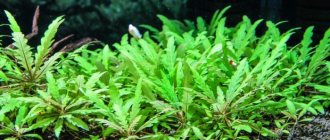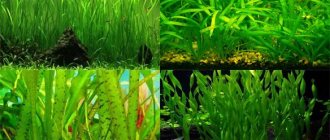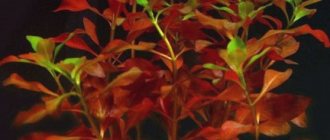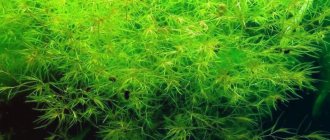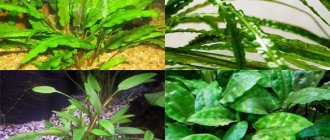The water banana is native to the southeastern United States . It grows in standing and slow-moving water.
The water banana has a shortened stem with a rosette of petiolate leaves. The leaf blade is round, up to 10 cm in diameter, with a deep notch at the place where the petiole is attached, fleshy. It is olive green above, pale purple below with clearly visible veins. The petiole is light green, covered with brown hairs, with air chambers, brittle. Its size, as a rule, depends on the water level in the aquarium. At the rhizome of a banana grows a cluster of elongated dark green formations up to 2 cm long and up to 0.6 cm wide, reminiscent of bananas. The adventitious roots are white, thick and cord-like.
Water banana is very sensitive to conditions, especially temperature and water hardness . Water parameters for optimal maintenance of a banana plant: hardness 5-10°, pH 6.0-7.2 (young plants do not tolerate increased acidity), temperature in summer - 25-27 °C, in winter - 15-18 °C. Prefers bright lighting (in such lighting it grows quickly). Planted in the foreground of the aquarium .
For water banana, soil that is poor in nutrients is suitable (to slow down the formation of floating leaves). The substrate is gravel. It is recommended to immerse “bananas” in the ground only 1/4 of the length.
Water banana reproduces by young plants that form on creeping shoots. In addition, a daughter plant is formed at the end of the petiole, cut off and left to float, but in this case it will not develop “bananas”. If the petiole left on the stem after separating the leaf is cut off at the very base, it also produces shoots. You can also cut off a whole leaf and press it into moist soil with high air humidity, in this case a daughter plant appears on it, which, after the formation of roots, is transplanted into an aquarium. Water banana grows slowly and produces 1-2 leaves per month.
Today there are many new species of aquarium plants that have taken their rightful place in the collections of experienced aquarists and are very popular. One such plant is Nymphoides "Flipper" (Taiwan). This is a perennial, fast-growing plant, which is distinguished by its unpretentiousness and original appearance.
Unfortunately, Nymphoides "Flipper" is not yet a defined species of water lilies, so there is no detailed information about its living conditions. However, based on previous experience in growing nymphs, the following conclusions can be drawn:
Nymphoides Flipper
Nymphoides flipper is a wonderful aquarium plant!
Habitat: Eastern Asia.
Height: 15 - 25 cm or more.
Width: from 10 to 15 cm or more.
Lighting: above average from 0.5 W/l.
Water hardness: preferably soft, kH below 7.
Water temperature: 18 – 30 ° C.
Nymphoides is a lush green aquarium plant with large, round leaves. This plant will look great in the background and middle ground of the aquarium.
The plant is simple and grows quite quickly. In bright light it grows more compactly; in lack of light it stretches out. Requires periodic trimming of old leaves. The plant is tender and fragile, does not like transplants. Propagated by cuttings.
Photo nymphoides flipper
Video nymphoides flipper
PRACTICAL NOTE ON GROWING AQUARIUM PLANTS
This note is posted in all FanFishka articles dedicated to aquarium plants. This is a cheat sheet with a link that will help you grow any aquarium plant and herbalist of any complexity.
First of all, the proper level of lighting is necessary.
(light intensity - Lumens)
Next, the proper concentration of CO2
Further macro-fertilizers and micro-fertilizers
Water parameters, care and quality water changes
The gradation of this formula is based on the degree of importance. Lighting intensity is primary, and then descending. Therefore, if your plants have holes in the leaves, they have sciatica (crooked) or there are problems with algae, then please do not read the “bad advice” - this is chlorosis (lack of iron), this is a lack of potassium... diarrhea, phimosis and endometriosis )
You always need to solve the problem of setting up an herbalist from major to minor. Plants will die more quickly from a lack of lighting than from a lack of Fe and K. Moreover, the latter are always present in one degree or another in the aquarium, but it is difficult to measure their precise value.
Below, let's go from the main to the minor.
Lighting in an aquarium with plants . Remember, the most important thing in light is its intensity (Lumens)! All other lighting characteristics: spectrum, Kelvin, PAR/PAR, Ra... are important, but secondary. There will be no intensity of lighting, there will be nothing. At the same time, the lighting intensity must be balanced - selected specifically for your project (height of the water column, number and types of plants, daylight hours).
Based on the above, choose aquarium lighting primarily by the number of lumens, and then everything else.
Lighting is the most expensive part. The most budget-friendly solution is to install ordinary construction-street floodlights above the aquarium . Fortunately, they are now very thin and aesthetic. And believe me, under them everything grows with a bang, of course, provided that all the other components are present.
In order not to be unfounded, here are photos of our herbalists, which were grown exclusively under LED spotlights or with their presence.
If you want professional lighting or aesthetics. Then you will have to fork out some money. The amounts can vary quickly from 10,000 to 50,000+ rubles for a 100 liter aquarium. It’s difficult to advise anything, because... Everyone has different needs and capabilities. In this article we talk about the products of our partners - Tetra , Laguna , ISTA lighting .
We tried to briefly and objectively talk about them. Then it's up to you. In any case, we do not really recommend that you pay attention to handicraft lighting assembly from folk craftsmen. Not all, but as a rule, they shove who knows what kind of diodes into such an assembly, assemble it all on their knees... and believe me, more than once on the forum you hear echoes of the consequences of such a purchase. After all, a company is a company. At a minimum, you are given warranty and post-warranty service.
If you are a beginner, your first herbalist, then LED spotlights are your choice. Let's move on, otherwise this note isn't very short =)
CO2 for aquarium plants . The plant is approximately 90% water, the remaining 10% is dry matter. Of that 10%, 46% is carbon. This is why CO2 supply is so important in a planted aquarium.
Plants in an aquarium obtain carbon “from water” - from carbon-containing compounds. But the natural concentration of C-carbon in water is small and is only sufficient for unpretentious plants, but they, and even more so, will be happy with additional carbon feeding. The supply of CO2 can be provided using mash or a CO2 balloon system , lemon juice or other methods.
The best, professional, simple and budget option is to supply carbon dioxide through a cylinder. One thing, however, is the initial purchase of a set: a cylinder, an MG valve, a diffuser…. will hit the budget.
Is it possible to do without CO2, but for a couple of bushes of simple plants ( cryptocorynes , echinodorus , most ludwigias , etc.).
What balloon systems can you recommend? The most budget option is an assembly from craftsmen who sell CO2 systems in VK and on forums. Everything is very high quality.
If you want a branded item, then we recommend the most inexpensive and at the same time high-quality CO2 systems from ISTA (Taiwan) . We have been using them for 5 years and recommend them to you.
Fish compatibility
Since the conditions for keeping nymphoides can vary widely, many species of fish can coexist with them. These plants do not disturb the biological balance in the aquarium environment. They have enough nutrients supplied by tap water and supplied by fish in the form of waste. The required amount of carbon dioxide comes from the air and is exhaled by aquarium fish.
To ensure the compatibility of plants and fish in the same aquarium, it is recommended to select species with similar habitat parameters. Due to their structure, nymphoides are not a place for spawning fish, and also do not serve as shelter in case of conflicts between them.
When creating an underwater world in an aquarium, you need to take into account that delicate plants are often perceived as food by African cichlids, goldfish, tilapia and other herbivorous species. Other inhabitants, such as catfish, like to dig up the soil, damaging plant roots in the process.
Bookmarks 0
Properties and Features
Nymphoides is also often found under the names "flipper", "Taiwanese flipper", "swamp flower", "water lily", "floating heart" and even "water fairy". Belongs to the Gentian family of perennial plants.
The roots are quite short, although it grows into quite large bushes from 15 to 25 centimeters in height and up to 15 centimeters in width.
Since its overall size is compact, the marsh flower is often used to decorate small aquariums. If the volume of the aquarium is very large, the plant can grow up to half a meter in length.
History of Marsilia
This plant dates back to the 18th century, it is named after the Italian botanist - Count L. Marsiglia. The merits of this scientist were the complete lists of plants that grew along the banks of the Danube that he compiled. But another more famous biologist of that time, Carl Linnaeus, who wrote down the structural features and vital functions of aquatic ferns unknown at that time, and decided to later name this genus after his respected scientific colleague.
What distinguishes Marsilea ferns from all genera of ferns is that they develop organs called sporocarps. Sporocarps are leaf lobules or entire leaves of aquatic ferns that initially form closed containers in which sori develop (Sorus are crowded pores or organs of asexual reproduction). The shape of sporocarps can be varied: spherical, bean-shaped, sometimes square and triangular. They develop mainly at the base of the petiole, because of this they may contain starch, which has nutritional properties. There are countries with tropical climates that eat marsilia.
Prevalence in nature
Nymphoides is quite widespread in different areas. In North America, it can be found in Florida, where it chooses calm, quiet waters for its habitat. It is often found in other areas of the United States - it can often be seen in warm bodies of water in Mexico.
Also, based on one of the names, the plant lives in the warm waters of Taiwan, especially the southern parts, without a strong current.
How to root ludwigia
The algae is demanding of the soil - its nutritional content and silt content. The delicate root system is difficult to tolerate the rough pebble bottom. For ludwigia, coarse sand is acceptable, and when planting, clay balls can be placed under the roots. Planting is possible in any part of the aquarium, however, given the height, the plant will look most harmonious in the background.
Important! When growing ludwigia, you must strictly follow the recommendations for its maintenance, as the plant may lose color and degenerate
Aquarium volume
When choosing the volume of an aquarium, you need to take into account the needs of its possible inhabitants and plants planned for planting. In the case of Ludwigia, the height of which, as mentioned above, is at least 30 cm, it is worth placing it in fairly spacious reservoirs with a height of the front (view) glass of less than 40 cm. The proportionality of the size of the aquarium also plays a role, therefore, when combining the width, height and depth at least in the proportion of 2:1:1, the volume will be from 100 liters.
Water
The quality and composition of water significantly affect the plant, so you need to monitor all indicators and replace old water in a timely manner.
Did you know? Various types of goldfish are considered to be the most common and long-lived inhabitants of an aquarium. One of the species named Fred lived for 41 years!
It is also worth keeping an eye on its main parameters.
- Temperature. Normal temperature is considered to be readings in the range from +20 to +24°C. In this mode, the stems and leaves do not freeze and do not grow abnormally, losing their aesthetic appearance.
- Rigidity. Water hardness should be within 10 degrees (one degree contains 10 mg of calcium oxide CaO). This figure corresponds to the boundary between medium-hard and soft water. This indicator seriously affects the development and flowering of plants.
- Acidity. The active reaction (acidity) of the water in the aquarium should fluctuate slightly within 6–7 pH. Under normal conditions, this is an average acidity level. It is necessary to ensure that there are no sudden changes in this indicator, as this can have a negative and detrimental effect on pets.
- Aeration and filtration. Ludwigia looks good when cared for, so the aquarium must have a filter and aeration system running at all times. In this case, all the aquarium debris will not settle on the leaves of the plant.
- Water purity. Partial water replacement also plays an important role in the comfortable life of the plant. Weekly replacement of a quarter of the aquarium's volume will significantly improve the living conditions not only of Ludwigia, but also of all other representatives of flora and fauna.
Lighting
The plant loves bright light, but direct sunlight must be shaded to avoid damaging the leaves. It is better to organize an additional source of artificial lighting, which will create comfortable conditions and will not damage the delicate algae tissue. The lamp power is selected at the rate of 0.5 W per liter of reservoir volume. Next, you need to monitor the behavior of plants, which, if there is insufficient light and warmth, will begin to shed their leaves, and if there is too much light, they will begin to develop rapidly and lose their attractive appearance.
Important! Daylight hours for Ludwigia should last at least 12 hours - then the pet will be pleased with its excellent appearance
Top dressing
The plant will accept mineral fertilizers containing iron with pleasure, significantly improving the appearance, color and growth of foliage. Fertilizers are placed on the surface of the soil near the roots or simply mixed with the aquarium water. The plant really likes to grow in a humid greenhouse, and after that it adapts well and quickly when transplanted into reservoirs.
Appearance
The leaves usually grow in the water column, although sometimes they can rise above its level, beginning to float on the surface. The leaf blade itself is bright green, the thin legs are painted in the same shade.
The shape of the leaf resembles a heart (from which Nymphoides received one of its names). The roots are dense, adjacent to each other, have a darker color and a long, rounded shape.
blooms with small white flowers that appear from under the leaves. There are usually about five petals, thin and small in size.
The water lily has high decorative qualities due to its compactness and the attractive appearance of its leaves, therefore it is very often used to decorate small and medium-sized aquariums. Such leaves look very beautiful against the background of other algae.
Aquadesign
In an aquarium, a water banana is used to create the center of the composition.
Provide it with a space of at least 15 cm. If the water banana is sinking and there is a calm flow of water in the aquarium, the plant can be left to grow freely on the surface of the soil. In this case, the roots will grow from the stem part down and over time will become fixed in the soil. The roots will start out bright white, but as they settle into the substrate they will turn dark green. Although the upper part of the root may remain white for quite a long time.
If Nymphoides does not sink, or there is a very strong current in the aquarium, the plant can be buried in the ground to help it gain a foothold. However, in this case, you should remember that you cannot bury the tubers in the ground more than 1 cm or 1/4 of their length.
In the pond, nymphoides are left to grow freely, forming leaves floating on the surface of the water. The water in the pond should not be stagnant; it is necessary to create a slight current, otherwise it may lead to the death of the plants.
The botanical genus Nymphoides includes plants - herbaceous hydrophytes that live in wetland environments. Nymphaeum, marsh flower, nymphoides are synonyms that are used in scientific and popular literature and in catalogs. All types of nymphaeans have a root system at the bottom of the reservoir and form a rosette of rounded leaves on long petioles that tend to the surface of the water. Nymphoides have become widespread as aquarium plants.
Aquarium plant Nymphoides.
Features of keeping in an aquarium
In order for a water lily to feel good in an aquarium, it is necessary to create special conditions, which is quite easy, since nymphoides is unpretentious. Sufficient levels of lighting and temperature, monitoring the condition of the plant and timely treatment are required.
It is also important to correctly combine the plant with the fish. It can be used for foreground decoration by placing it in gravel or other small pebbles. It goes well and looks good against the background of black soil in the aquarium.
Since Nymphoides is a heat-loving plant, it is necessary to provide it with a temperature of +25-28°C. The lower mark should not fall below 21 degrees, although the water lily can survive changes from 18 to 30°C.
The acidity level in the water should be 6.0-7.5 - if it is higher, young plants may die. Swampweed tolerates conditions well and grows in hard water with high alkalinity, but it is best to stick to a level of 3 to 6 on the hardness scale.
It is also important to ensure filtration of the water mass. A moderate level is appropriate for this plant, as it grows in standing water and does not like movement very much. Cleaning the aquarium and changing the water should be done at least once a month, although nymphoides is not afraid of excess dirt.
Although the water lily is considered an amphibian, that is, it can grow both in water and on the surface, it is necessary to monitor the water level. If it falls in the aquarium, the leaves that are above the water level begin to dry out, and this can lead to the death of the entire plant.
Priming
Since the plant’s root system is not very large, it is better to choose medium-sized soil for planting.
Gravel is perfect for this purpose, but other small stones can also be used. If the filler is very fine, this can lead to souring, but large stones will cause failures and accumulation of waste.
Lighting
According to various sources, the water banana tolerates different types of lighting, so it is suitable for growing not only by beginning fish lovers, but also by experienced breeders. It tolerates bright light normally, but moderate daylight is sufficient for a good growth rate.
In such conditions, a new leaf appears every two weeks, tubers and roots develop well.
Nymphoides can also grow in the shade of other algae, although in such conditions it will develop more slowly. In general, the light from the lamp on the lid of the aquarium is enough for him. The duration of lighting during the day should range from 10 to 14 hours.
Planting and propagation
Water banana is propagated by division. Usually it is enough to simply divide the roots into two parts, and you will have two plants. After division, all the old leaves die off, but very soon new shoots appear. However, it is recommended to purchase and plant new plants every 5-6 years.
Fish compatibility
Suitable for any aquarium with all types of fish. It takes root and grows well, serves as a natural cleanser and maintains the necessary biological balance. Rarely becomes food for aquarium inhabitants if a good level of feeding is provided.
It can germinate in almost any conditions, so it survives in the vicinity of not only peaceful, but also predatory fish. Suitable for decorating any aquarium.
Rules for choosing when purchasing
Plants for an aquarium can be purchased both from amateur aquarists and in specialized stores.
When buying nymphoides, you should first carefully evaluate the condition of the stem and leaves. The shortened stem should be green, dense, and not damaged. The leaves of a healthy, well-formed shoot are dense, smooth, undamaged, young ones are lighter than adults. If there is damage, you must make sure that there are at least 3 healthy leaves, as damaged ones will have to be removed.
It is important that the seedling shows no signs of algae growing on different parts of the plants. When it comes to Water Banana, the presence of healthy tubers is a must, and there should be a lot of them, at least 7.
Nymphoides sp. "Taiwan") » Home aquarium
Under natural conditions, the swamp flower "Taiwan" grows in reservoirs on the Asian continent, in southern Taiwan, which is reflected in the name of the plant. For the first time in Russia, this plant appeared on sale in 1994, when it was imported from Taiwan by the Dennerle nursery. The plant is not picky and can be recommended for keeping in the aquarium of beginning amateur aquarists.
The plant has leaves growing in the water column. According to some sources, this variety of bogflower does not produce emergent leaves, but this statement is not entirely correct. Leaves do not grow when above water, but as the plant grows, it reaches the water level and its leaves begin to float on the surface. The leaf blade is painted bright green. In general, the plant is of medium size and is suitable for growing in medium-sized aquariums. In aquarium conditions, the swamp flower "Taiwan" reaches a height of 25 cm, a width of about 15 cm and is characterized by a high growth rate. Water parameters that satisfy the plant should be as follows: temperature 21-28°C, hardness dH 2-30°, acidity pH 5.9-7.3. Regular fertilizing with CO2 in a ratio of 4-5 mg/l is required. The plant relatively easily tolerates sudden changes in water temperature from 18 to 32°C.
In general, growing swampweed "Taiwan" in aquarium conditions does not cause any particular difficulties, because Grows in virtually any water. The plant is able to grow in the shade of other plants, but lighting should not be neglected, because nevertheless, the plant grows much better and looks more decorative when brightly lit. You can plant bogflowers both in the foreground and in the background, singly or in a group. With any of these combinations, the plant does not lose its attractive appearance.
It is better to use sand or fine gravel as soil. The soil should be rich in nutrients and moderately silted.
Lighting should be of medium brightness, intensity about 0.25-0.3 W/l.
It should be taken into account that the leaves of the plant are very tender and wither relatively quickly when out of water. For this reason, the plant must be transported only in water and planted in an aquarium already filled with water.
The swamp flower "Taiwan" propagates vegetatively, by forming young shoots along the border of old leaves. It is also possible to get a new plant by transplanting an adult leaf to a new place, having previously cut it off from the stem. Relatively quickly it will take root and produce new leaves. In order for the plant to look beautiful in the aquarium, it is advisable to periodically remove old darkened leaves and long shoots.
Occasionally, under acceptable conditions, the "Taiwan" marsh flower can bloom, producing beautiful emergent flowers.
Found an error or a dead link?
Select the problematic fragment with the mouse and press CTRL+ENTER. In the window that appears, describe the problem and send it to the resource Administration.
houseaqua.ru
Description
This flora is called "water banana" because it has thick green tubers similar to the famous tropical fruit. However, in general it has many name variations. For example, water lily, floating heart, banana lily, etc.
Natural habitat - North America. These are generally calm rivers and lakes in Florida. However, the flora can also be seen in the rest of the United States and Mexico. The bushes have thick green tubers and leaves that stretch to the upper layers, and are shaped like a floating lily. The leaf blade has a bright green color. The color is affected by the light intensity.
Nymphoides may bloom. During this period it produces white flowers. When planted in an aquarium, the bush adapts for the first time. When it gets used to the new water parameters, it will begin to send out long stems to the surface, on which leaves will soon grow. However, it is better to remove the shoots, as they can destroy the lower part of the plant. If you leave them, the stems rot and a floating form of flora appears in the aquarium.
The height of the bush can vary from 5 to 15 cm. Width – 5-10. If planted in a pond, its size can be about 45 by 45 cm. It has a moderate growth rate. It is considered an amphibious plant because it can grow either completely in an aquatic environment or partially submerged in it.

